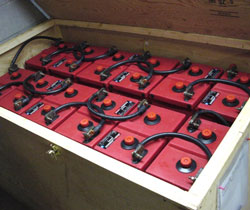Posted on
By: Steve MaxwellUpdated on November 22nd, 2015
Off-the-grid power systems are more practical and affordable than ever, and the best set-ups I’ve seen include a mix of technologies. The starting point should be photovoltaic (PV) panels. They sit on your roof and make electricity from sunlight, silently and without any moving parts. Any array of panels you choose needs to be large enough to generate a total stored quantity of electrical power that’s sufficient for most of the time when you want to operate equipment while the sun is blocked by clouds or it’s nighttime. Power from your PV panels will charge a bank of batteries that can be used to power items directly that are designed to use direct current, or converted into 120 volt power of the sort used to energize small or medium-sized plug-in household appliances. Cooking  requires more power than is practical to provide with photovoltaics, and that’s why many people combine PV with propane for cooking and sometimes refrigeration. Depending on your expectations for having electrical power always available, you might also consider supplementing your system with a gasoline powered back-up generator. This can be used to charge batteries when the PV panels can’t keep up, or when you want more electrical power than the battery system can provide.
requires more power than is practical to provide with photovoltaics, and that’s why many people combine PV with propane for cooking and sometimes refrigeration. Depending on your expectations for having electrical power always available, you might also consider supplementing your system with a gasoline powered back-up generator. This can be used to charge batteries when the PV panels can’t keep up, or when you want more electrical power than the battery system can provide.
At this stage, the typical way for people to make alternate energy systems part of their lives does not necessarily involve choosing and installing each component from scratch. A growing number of retailers are offering photovoltaic packages and technical guidance, and this takes a lot of the guesswork out of living beyond the grid.